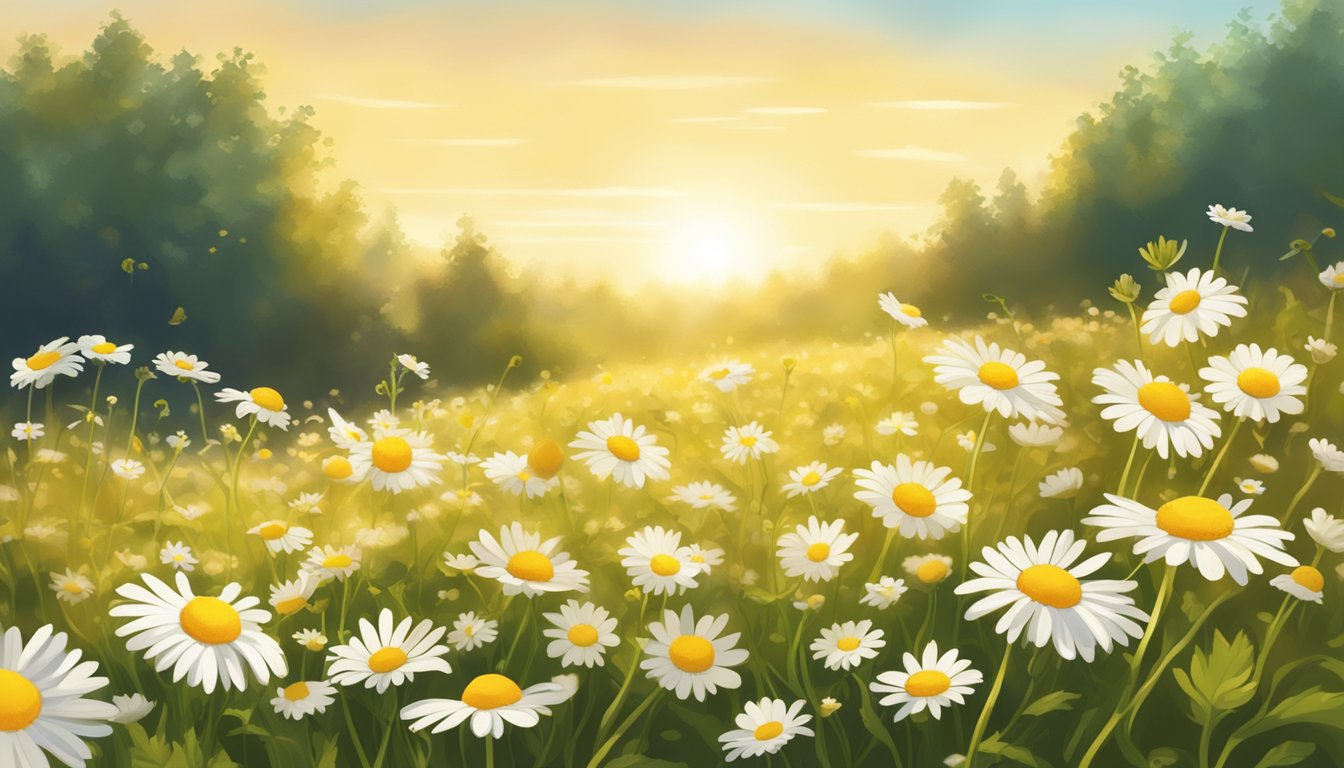TheHerbProf.com is a treasure trove of knowledge for those interested in natural healing and herbal remedies. The website is run by Paul Johnston MD. A naturopathic who has not only received extensive education in the field but also has personal experience in self-healing.
Chamomile vs daisy are two common flowers that are often confused with each other due to their similar appearance. Both belong to the Asteraceae family and are native to Europe and North America. However, there are some distinct differences between the two species that set them apart.
Chamomile is a small, daisy-like flower with a yellow center and white petals. It is commonly used in teas and essential oils for its calming properties. There are two main species of chamomile: German chamomile and Roman chamomile. German chamomile is an annual plant that grows up to 2 feet tall and has a strong, bitter taste. Roman chamomile is a perennial plant that grows up to 1 foot tall and has a sweet, fruity taste.
Daisies, on the other hand, are larger and have a wider range of colors and shapes. They have a yellow center surrounded by white or colored petals that can be spoon-shaped or elongated. Daisies are often used in floral arrangements and are a popular choice for gardens due to their hardy nature. There are over 20,000 species of daisies, including the African daisy, Shasta daisy, and oxeye daisy.
Characteristics of Chamomile Vs Daisy
As a flower enthusiast, I have always been fascinated by the differences between daisies and chamomile. These two flowers belong to the Asteraceae family and have similar characteristics, but they also have some distinct differences that set them apart.
Petals
One of the most noticeable differences between daisies and chamomile is the petals. Daisies have white or yellow petals that surround a yellow center, while chamomile petals are white with a yellow center. However, some species of daisies have pink or red petals, which can make them look similar to chamomile.
Size
Chamomile vs daisy also differ in size. Daisies are generally taller than chamomile and can grow up to 3 feet tall, while chamomile is shorter and usually grows up to 1 foot tall. Daisies bloom in the summer and fall, while chamomile blooms in the spring and summer.
Stems and Leaves
Daisy stems are sturdier and tend to be more upright, while chamomile stems are thin and delicate. Additionally, chamomile tends to grow lower to the ground and forms a mat-like shape, while daisies are taller and have a more upright growth habit. Both flowers have green leaves, but chamomile leaves are more feathery and delicate.
Pollen Buds
The pollen buds of daisies and chamomile are also different. Daisy pollen buds are blue or brown, while chamomile pollen buds are yellow.
Daisies and chamomile are both beautiful flowers with unique characteristics. While they may look similar at first glance, they have distinct differences in their petals, size, stems and leaves, and pollen buds. These differences make them suitable for different growing conditions and uses such as chamomile tea and medicinal properties.
Differences in Appearance Between Chamomile Vs Daisy
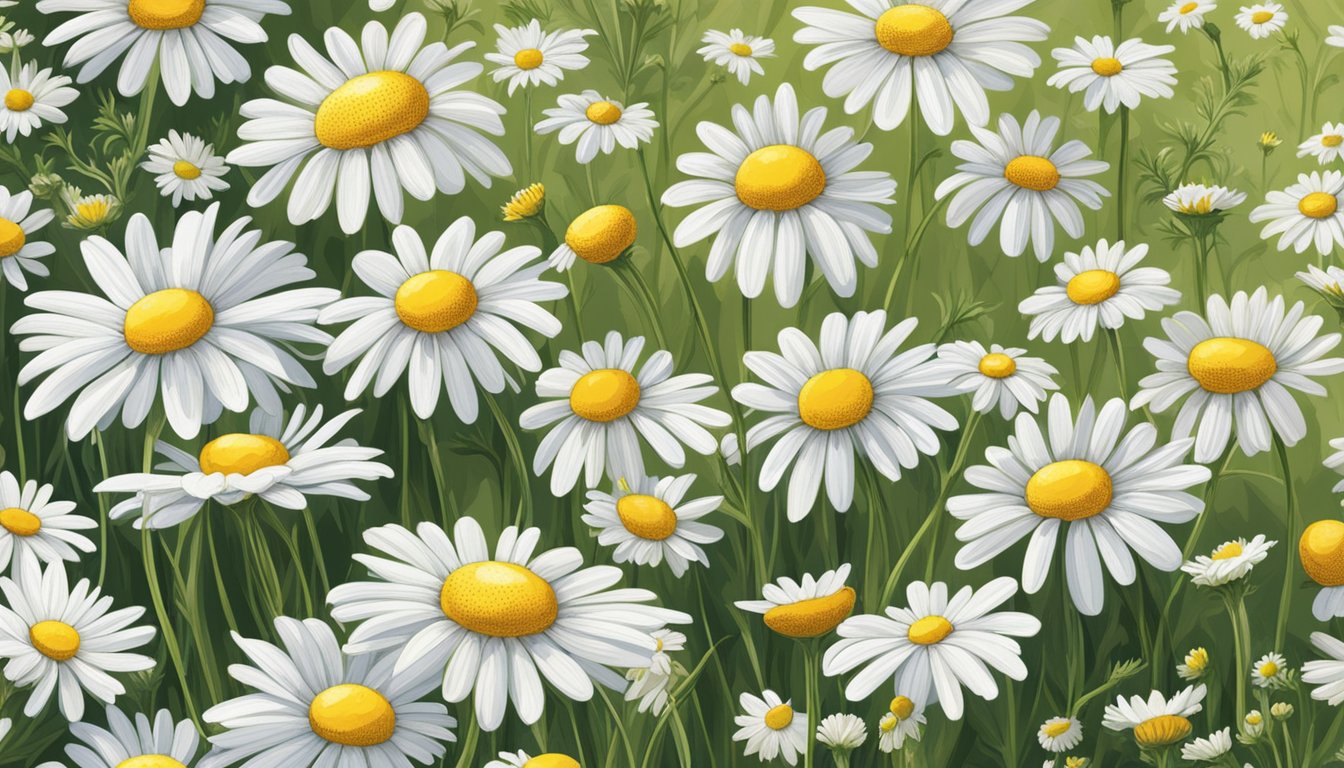
As both daisies and chamomile belong to the same family, Asteraceae, they share some similarities in appearance. However, there are some key differences that can help you differentiate between the two.
Leaf Shape
One of the most noticeable differences between daisies and chamomile is their leaf shape. Daisy leaves are typically broader and have a serrated edge, while chamomile leaves are more delicate and feathery. Chamomile leaves are also thinner and more thread-like than daisy leaves.
Flower Color
Daisies and chamomile have different flower colors, which can help you identify them. Daisies usually have white petals with a yellow center, although some species may have pink or yellow petals. Chamomile flowers, on the other hand, are typically white with a yellow center. However, some species of chamomile may have pink or yellow flowers as well.
Pollen Bud Variations
Another way to distinguish between daisies and chamomile is by looking at their pollen buds. Daisy pollen buds are usually round and compact, while chamomile pollen buds are more elongated and less compact. Additionally, chamomile pollen buds may have a small protrusion at the tip, which is not present in daisy pollen buds.
Daisies and chamomile have distinct differences in appearance that can help you identify them. While daisies typically have broader leaves and white petals with a yellow center, chamomile has more delicate, feathery leaves and white petals with a yellow center. Additionally, chamomile pollen buds are more elongated and less compact than daisy pollen buds.
Similarities Between Chamomile Vs Daisy
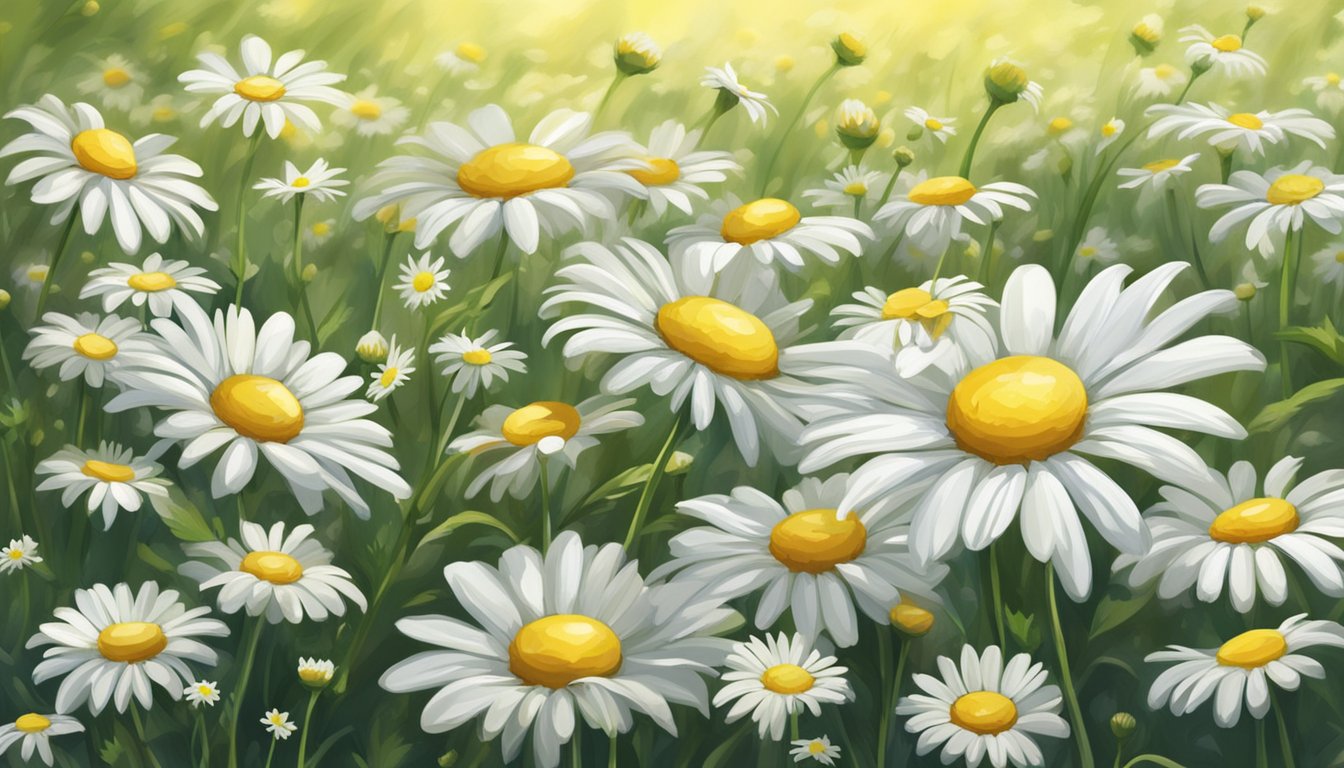
Both Members of the Daisy Family
Daisies and chamomile share a common family, which is the Asteraceae family. This family is also known as the daisy family, and it includes many other plants such as sunflowers, marigolds, and asters. Both chamomile and daisies have a similar appearance with white petals and yellow centers. However, chamomile flowers are much smaller than daisy flowers.
Can Have Medicinal Uses
Both chamomile and daisies have been used for medicinal purposes for centuries. Chamomile tea, which is made from the dried flowers of German chamomile, Roman chamomile, or Matricaria chamomilla, is known for its calming effect and is often used to treat anxiety and insomnia. Similarly, daisy tea, which is made from the dried flowers of Bellis perennis, is known for its anti-inflammatory properties and is used to treat respiratory problems and digestive issues.
Both chamomile and daisies are also used in various forms of alternative medicine, such as aromatherapy and homeopathy. Chamomile essential oil is used to relieve stress and anxiety, while daisy essential oil is used to soothe skin irritation and inflammation.
While chamomile and daisies have many differences, they also share some similarities. They are both members of the daisy family and have been used for medicinal purposes for centuries.
Before You Go – Chamomile Vs Daisy – Which Do You Prefer?
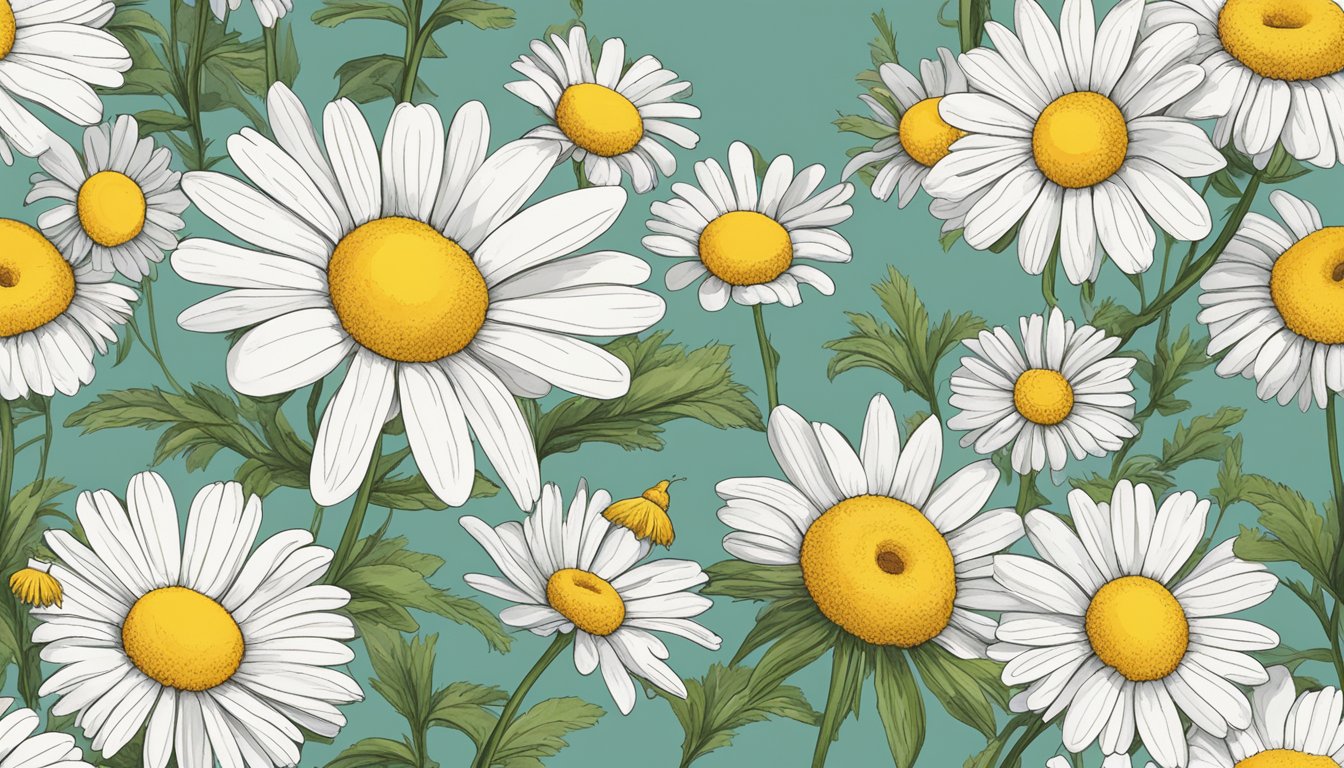
After researching the differences between chamomile and daisy, I have come to appreciate both flowers for their unique qualities. However, depending on your needs and preferences, you may find one to be more suitable than the other.
If you are looking for a fragrant flower, both chamomile and daisy have a pleasant scent. Chamomile has a sweet, apple-like fragrance, while daisy has a mild, slightly sweet scent.
When it comes to tea and culinary use, chamomile is the clear winner. Chamomile tea is a popular herbal remedy for relaxation and sleep, and can also be used in baking and cooking. Daisy, on the other hand, is not commonly used in tea or cooking.
In terms of growing requirements, chamomile prefers full sun and well-draining soil, while daisies can tolerate a bit more shade and prefer slightly moist soil. Both flowers can be grown from seed, but chamomile can also be propagated through division.
It is worth noting that there are different types of chamomile, including wild chamomile (Matricaria recutita) and Roman chamomile (Chamaemelum nobile). Wild chamomile is a hardier plant that can handle hot, dry summers and requires less watering than Roman chamomile.
Overall, the choice between chamomile and daisy comes down to personal preference and intended use. Whether you prefer the soothing properties of chamomile tea or the cheerful blooms of daisy, both flowers are a great addition to any garden.
Chamomile Vs Daisy: A Connection with TheHerbProf.com
Chamomile and Daisy, two beauties in the world of flowers! Now, let’s see how they link to TheHerbProf.com.
Chamomile is all about the calming power of nature. It’s like a soothing lullaby, bringing peace to your senses. Now, mix this with the herbal wisdom of TheHerbProf.com, and you’ve got a tranquility treasure!
Daisy, on the other hand, is the symbol of innocence and purity. It’s like the cheerful child, bringing joy with its simple beauty. When you pair this with the insights from TheHerbProf.com, it’s like having a joy jar in your pocket!
For example, love the calming tea made from Chamomile? Hop over to TheHerbProf.com to learn more about its soothing properties. It’s like a tranquility journey, and you’re the explorer!
Or maybe you’re charmed by the simple beauty of the Daisy? Swing by TheHerbProf.com to discover its symbolic significance. It’s like a journey into the heart of innocence, and you’re the adventurer!
In essence, Chamomile, Daisy, and TheHerbProf.com are like three petals in a perfect flower. One brings the calm, one brings the joy, and one brings the knowledge. Together, they create a harmonious blend for any flower enthusiast!
References – Chamomile Vs Daisy
Little Herb Encyclopedia, by Jack Ritchason; N.D., Woodland Publishing Incorporated, 1995
The Ultimate Healing System, Course Manual, Copyright 1985, Don Lepore
Planetary Herbology, Michael Tierra, C.A., N.D., Lotus Press, 1988
Handbook of Medicinal Herbs, by James A. Duke, Pub. CRP Second Edition 2007
The Complete Medicinal Herbal, by Penelope Ody, Published by Dorling Kindersley
Check the Following Articles!
Shaklee Herb Lax Review: An Analysis of Its Effectiveness
Herbal Essences Shampoo Review For Hair Fall
Catmint Vs Catnip: What’s the Difference?
Frequently Asked Questions – Chamomile Vs Daisy
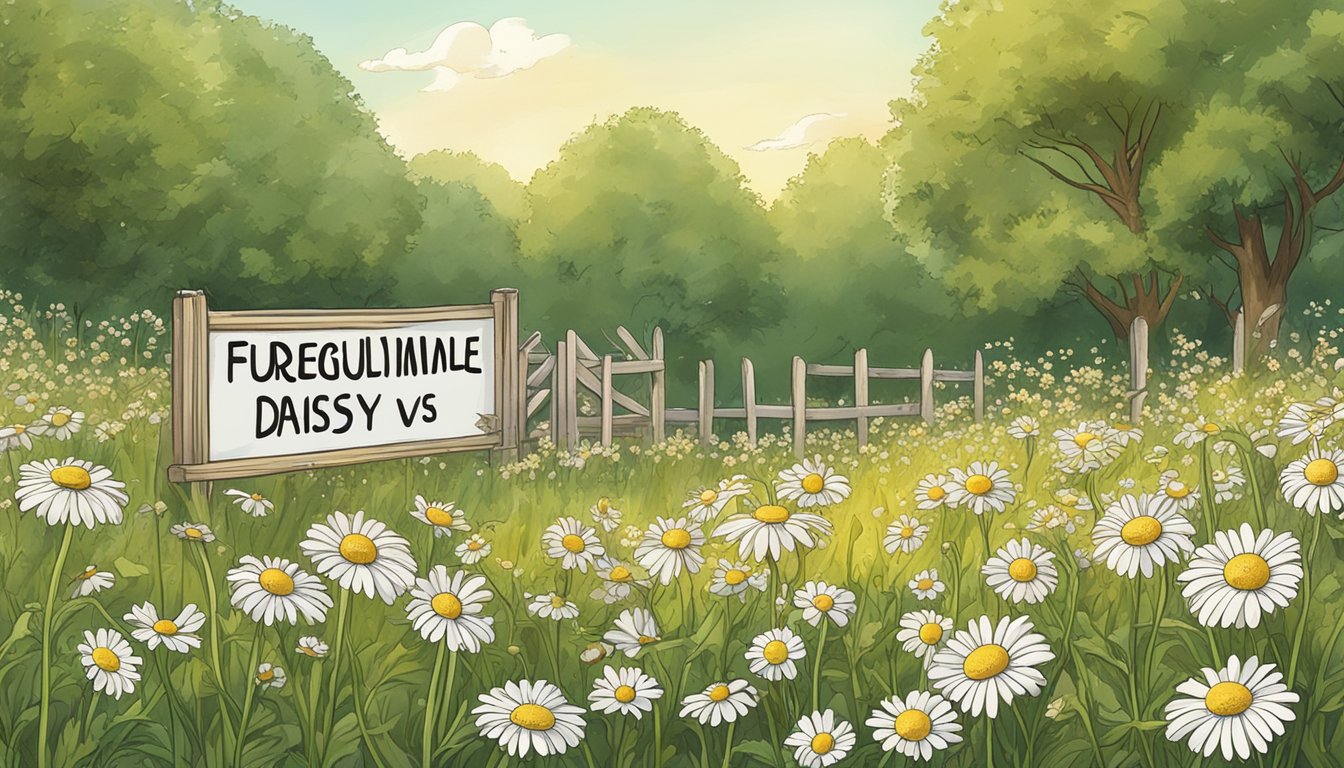
What distinguishes chamomile from other daisy family members?
Chamomile is a member of the daisy family, Asteraceae. It is often confused with other members of the family, such as daisies. However, chamomile can be distinguished from other daisy family members by its small, white, daisy-like flowers with yellow centers. Chamomile flowers have a sweet, apple-like fragrance, which is another distinguishing feature.
Can chamomile leaves be used in herbal remedies?
Yes, chamomile leaves are commonly used in herbal remedies. Chamomile leaves contain essential oils that have anti-inflammatory and anti-spasmodic properties. They can be used to make teas, tinctures, and poultices that are used to treat a variety of ailments, including digestive problems, anxiety, and skin irritations.
How can I identify true chamomile seeds for planting?
True chamomile seeds can be identified by their small, oblong shape and light brown color. They are also slightly curved and have ridges running along their length. When planting chamomile seeds, it is important to choose a variety that is suitable for your growing conditions, as some types of chamomile prefer cooler temperatures and moist, well-drained soil.
What are the medicinal properties of daisy flowers?
Daisy flowers are known for their anti-inflammatory and pain-relieving properties. They have been used for centuries to treat a variety of ailments, including headaches, menstrual cramps, and arthritis. Daisy flowers also contain antioxidants that can help protect the body against damage from free radicals.
Are there any toxicities associated with chamomile plants?
Chamomile is generally considered safe when used as directed. However, some people may be allergic to chamomile, and it can cause allergic reactions in some individuals. Chamomile should not be used by pregnant or nursing women, as it may cause uterine contractions.
Which plant is commonly confused with chamomile and how can I tell them apart?
One plant that is commonly confused with chamomile is pineapple weed (Matricaria discoidea). Pineapple weed is a member of the same family as chamomile and has similar flowers, but it has a distinctive pineapple-like scent when crushed. Another way to tell the two plants apart is by their leaves – pineapple weed has fern-like leaves, while chamomile has feathery, finely divided leaves.
